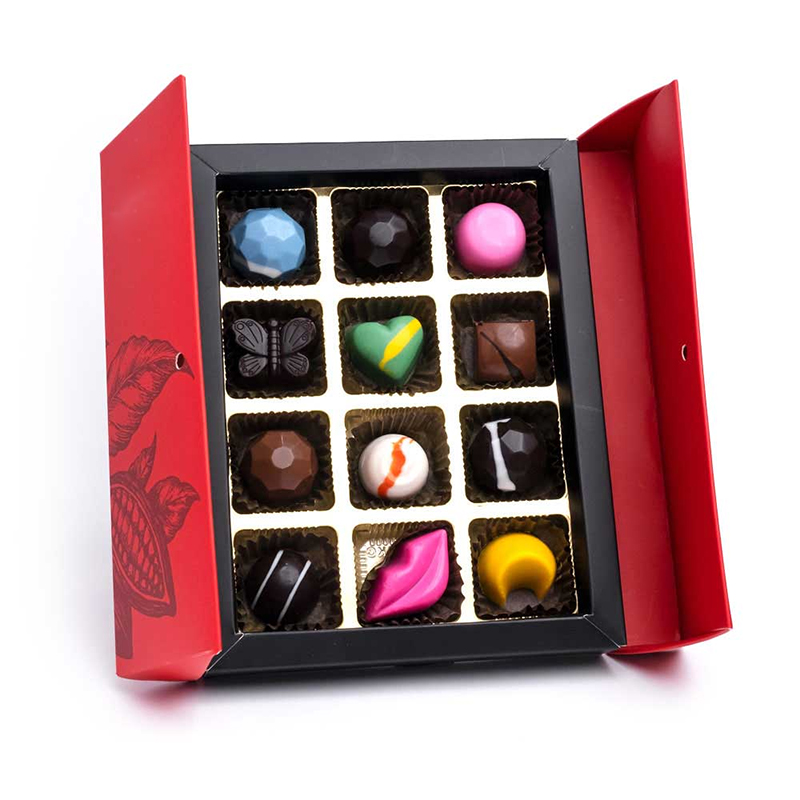- All
- Product Name
- Product Keyword
- Product Model
- Product Summary
- Product Description
- Multi Field Search
Views: 198 Author: XianDa Publish Time: 2025-02-11 Origin: Site

Content Menu
● How to Enhance Chocolate Box Cake Mix
● Understanding the Basics of Chocolate Box Cake Mix
● Ingredient Swaps for Better Flavor
● Creative Additions to Enhance Texture and Flavor
● Advanced Baking Techniques for Optimal Results
● The Chocolate Manufacturing Process and the Role of a Chocolate Box Factory
Boxed chocolate cake mixes are a convenient and accessible way to whip up a delicious dessert with minimal effort. Whether you're a novice baker or a seasoned pro looking for a quick and easy treat, these mixes provide a solid foundation. However, many bakers seek to elevate these mixes to create cakes that taste homemade and gourmet, surpassing the standard box-mix flavor. This article will explore various methods to enhance chocolate box cake mixes, focusing on ingredient substitutions, creative additions, advanced techniques, and a deeper look into chocolate production, including the role of a “chocolate box factory.”
Chocolate box cake mixes typically contain a pre-measured blend of flour, sugar, cocoa powder, leavening agents (like baking powder or baking soda), emulsifiers (like lecithin), and sometimes artificial flavors or preservatives. While these mixes provide a solid and reliable foundation for a cake, enhancing them can significantly improve the flavor, texture, and overall enjoyment. The key is understanding how each component interacts and what you can do to manipulate the ingredients to achieve your desired result.
1. Replace Water with Dairy
One of the simplest yet most impactful ways to enhance a boxed chocolate cake mix is by substituting the water with dairy products. This swap introduces richness, moisture, and complex flavors. Here are some options:
Whole Milk or Buttermilk: Using whole milk instead of water adds a noticeable richness and depth of flavor. Buttermilk, with its slightly tangy taste, complements chocolate beautifully, creating a more nuanced flavor profile. Buttermilk also has a higher acidity, which helps tenderize the gluten in the flour, resulting in a more tender crumb.
Milk being poured into a mixing bowl. A visual representation of substituting water with milk.
Sour Cream or Yogurt: Incorporating sour cream or plain yogurt (Greek or regular) not only adds moisture but also contributes to a denser, more luxurious texture. These dairy products contain fat and protein, which enhance the cake's richness and help it retain moisture, preventing it from drying out quickly.

2. Add Extra Eggs
Most boxed cake mixes call for a specific number of eggs. Adding an extra egg or two can significantly improve the richness and fluffiness of the cake. The additional eggs act as emulsifiers, helping to bind the ingredients together, improving the texture, and adding stability to the batter. The yolks contribute richness and fat, while the whites add lightness and airiness.
Cracking an extra egg into a mixing bowl. A visual of adding an extra egg to the cake mix.
3. Use Melted Butter Instead of Oil
Many boxed mixes recommend using vegetable oil, which provides moisture but little flavor. Swapping the oil for melted butter (preferably unsalted, so you can control the salt level) enhances the flavor significantly. Butter provides a richer, more complex taste and contributes to a better crumb structure, resulting in a more tender and flavorful cake.
Melted butter being poured into a mixing bowl. Illustrating the substitution of oil with melted butter.
4. Incorporate Instant Coffee or Espresso Powder
Adding one or two tablespoons of instant coffee or espresso powder is a classic trick to intensify the chocolate flavor without overpowering it. The coffee enhances the depth of flavor, bringing out the subtle notes in the cocoa and making the cake taste more complex and luxurious. It doesn't necessarily make the cake taste like coffee, but it amplifies the chocolate notes.
Adding espresso powder to the cake mix. A visual aid showing the incorporation of espresso powder.
1. Chocolate Pudding Mix
Incorporating a box (about 3.4 ounces) of instant chocolate pudding mix into your cake batter can add both moisture and density. The cornstarch in the pudding mix helps to stabilize the cake, preventing it from collapsing and ensuring a moist crumb. Plus, it gives an extra boost of chocolate flavor.
Adding chocolate pudding mix to the batter. A demonstration of adding chocolate pudding mix.
2. Flavored Extracts
Adding extracts such as vanilla, almond, or even orange can introduce new dimensions of flavor that complement chocolate beautifully. A teaspoon of vanilla extract is often recommended for enhancing the overall flavor, but a touch of almond extract can add a sophisticated and subtle nutty note. Orange extract pairs exceptionally well with dark chocolate, creating a bright and citrusy counterpoint to the richness of the chocolate.
Pouring vanilla extract into the cake batter. Illustrating the use of flavored extracts.

3. Mix-Ins
Consider adding mix-ins like chocolate chips (milk, dark, or white), chopped nuts (walnuts, pecans, or almonds), or even fruit (like mashed ripe bananas, raspberries, or cherries) for added texture and flavor complexity. Chocolate chips will melt into the batter during baking, creating pockets of gooey chocolate throughout the cake. Nuts add a delightful crunch, while fruit provides moisture and bursts of flavor.
Adding chocolate chips and walnuts as mix-ins. Showcasing a variety of mix-ins.
1. Blooming the Cocoa Powder
"Blooming" cocoa powder involves whisking it with hot water or hot coffee before adding it to the rest of the batter. This process releases more flavor from the cocoa powder, resulting in a richer, more intense chocolate taste. Let the mixture sit for a few minutes before incorporating it into the wet ingredients.
2. Proper Mixing
When preparing your batter, be careful not to overmix once you add the dry ingredients to the wet ones. Overmixing develops the gluten in the flour, leading to a tough cake. Instead, mix until just combined, ensuring that there are no large lumps of flour remaining.
3. Bake at the Right Temperature and Time
Ensure your oven is properly preheated to the correct temperature (usually 350°F or 175°C) before placing your cake inside. Baking at too low a temperature can result in an undercooked center, while too high can lead to burnt edges. Use an oven thermometer to verify the accuracy of your oven's temperature. Also, be careful not to overbake the cake. Insert a toothpick into the center; if it comes out with a few moist crumbs attached, the cake is done.
4. Use Quality Chocolate
The quality of the chocolate you use in your recipe matters significantly. If your recipe calls for melted chocolate or chocolate chips, opt for high-quality brands that use real cocoa butter (rather than vegetable oils) for a better flavor and texture. Look for chocolate with a high percentage of cocoa solids for a richer, more intense chocolate taste.
Understanding how chocolate is produced can also inform your baking practices. Chocolate production is a complex process that involves several stages, often concentrated within facilities referred to as a "chocolate box factory," where raw materials are transformed into the chocolate we enjoy. These factories play a crucial role in ensuring the quality and consistency of chocolate products.
Harvesting Cacao Beans: Cacao pods are harvested from cacao trees, typically in tropical regions. The beans are extracted from the pods and then fermented to develop their characteristic flavors.
Cacao pods being harvested. The origin of the chocolate flavor.
Roasting: The fermented beans are roasted at controlled temperatures to further develop their flavors and aromas. The roasting process is critical in bringing out the unique nuances of the cacao beans.
Roasting cacao beans. Roasting brings out the best flavors.
Grinding and Refining: The roasted beans are ground into a thick paste called chocolate liquor, which contains both cocoa solids and cocoa butter. This liquor is then refined to reduce particle size and improve the texture.
Conching: Conching is a crucial process that involves continuously mixing and aerating the chocolate liquor for an extended period (often hours or even days). This process refines the texture, removes unwanted acids, and further develops the flavor.
Tempering: Tempering is a critical step in ensuring that the cocoa butter in the chocolate crystallizes in a stable form, giving the chocolate a smooth, glossy appearance and a crisp snap. This involves carefully cooling and reheating the chocolate to specific temperatures.
Molding and Packaging: Finally, the tempered chocolate is poured into molds to create bars, shapes, or other confectionery products. The finished chocolate is then packaged for distribution. The packaging, often designed to be visually appealing, is a critical element in marketing the chocolate, and this is another area where "chocolate box factories" excel.
Using high-quality chocolate sourced from reputable manufacturers, such as those operating sophisticated "chocolate box factories," ensures that your baked goods have superior flavor profiles and textures. Understanding this process and the role of these factories provides valuable insight when choosing ingredients for your baking projects.
Enhance this article with images and videos demonstrating each technique:
Photos showcasing before-and-after results of cakes enhanced with different ingredients.
A video tutorial on how to properly incorporate dairy into boxed mixes.
Infographics illustrating the chocolate manufacturing process from bean to bar.
Visual representations of "chocolate box factories" and their production lines.


Q1: Can I use almond milk instead of regular milk?
A1: Yes! Almond milk can be used as a substitute; however, it may alter the flavor and texture slightly, as almond milk has less fat and protein than dairy milk.
Q2: What if I don’t have eggs?
A2: You can replace each egg with 1/4 cup of unsweetened applesauce, 1/4 cup of mashed banana, or 1/4 cup of yogurt as an egg substitute. Flax eggs (1 tablespoon of ground flaxseed mixed with 3 tablespoons of water) are also a good vegan option.
Q3: How do I store leftover cake?
A3: Store leftover cake in an airtight container at room temperature for up to three days or refrigerate it for longer freshness (up to a week). Adding a slice of bread to the container will help the cake retain moisture.
Q4: Can I freeze my enhanced cake?
A4: Yes! Wrap it tightly in plastic wrap and then in aluminum foil before freezing for up to three months. Thaw the cake in the refrigerator overnight before serving.
Q5: What’s the best way to frost my enhanced cake?
A5: Allow your cake to cool completely before frosting. Consider using cream cheese frosting for added richness, chocolate ganache for a decadent treat, or a classic buttercream frosting for a lighter option.
Enhancing a boxed chocolate cake mix is a rewarding way to create delicious desserts that impress family and friends without requiring extensive baking skills or a significant time investment. By making simple ingredient swaps, incorporating creative additions, and employing advanced baking techniques, you can transform an ordinary box mix into an extraordinary treat that rivals those from professional bakeries. Understanding the chocolate manufacturing process, including the role of a "chocolate box factory," further elevates your baking knowledge and helps you make informed decisions about the ingredients you use. So go ahead, experiment with these tips, and create your own signature enhanced chocolate cake!